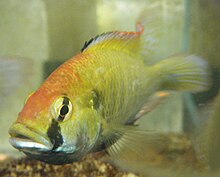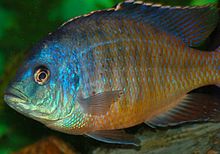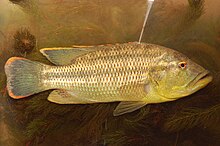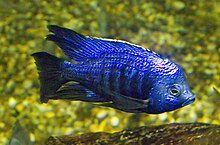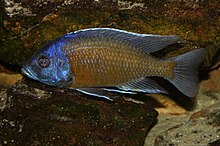Fauna of Lake Malawi
The East African Lake Malawi is one of the freshwater biotopes rich in fish species on earth. The lake's estimated 700 to 800 species of cichlids (over 450 described so far ) form one or two schools of species that have evolved from one or two original species. These are also the largest known swarms of species among vertebrates . To date, almost 60 endemic species of cichlid and over 450 species of fish have been described from Lake Malawi. Numerous species are still undiscovered or undescribed.
The lake's water is unusually alkaline with a pH of 7.7 to 8.6 . It has a total hardness of 4 to 6 ° dGH, a carbonate hardness of 6 to 8 ° dKH and a conductivity (at 20 ° C) of 210 to 285 μS / cm, a surface temperature of 24 to 29 ° C and a deep temperature of 22 ° C. The visibility in the lake is 20 meters. There are no more fish in the zone below 100 to 200 meters because the water there is too poor in oxygen.
Habitats
The most species-rich biotope of Lake Malawi is the scree zone, which often covers the first ten to twenty meters of the shore zone and extends down to a depth of two meters. Here the ground is thickly covered with stones the size of a fist or a football, between which there are many small caves and crevices. Above all, Labidochromis species live here . The second most important habitat is the Felslitoral, often designed as a steep coast without shallow water. The ground here consists of larger to huge boulders, so that there are fewer but much larger caves and crevices. Mainly Chindongo , Maylandia and Pseudotropheus species live here. Cichlids of the scree zone and the rocky coast form territory and live individually or in pairs. In contrast, the sandy shore is relatively poor in species. The vegetation-free sand zone is inhabited by Lethrinops species and other Haplochromini . Hemitilapia oxyrhyncha is a typical inhabitant of the sandy bank overgrown with reeds or submerged water plants, especially Vallisneria , who, lying on its side, grabs the ribbon-like leaves of the Vallisneria with its pointed mouth and literally sucks them off in order to strip off the algae and microorganisms that the Colonize leaves. The genera Copadichromis and Mchenga live in the open water ( pelagial ) of Lake Malawi, which are called Utaka after a local name . These plankton-eating cichlids live in huge swarms of several thousand specimens and, adapted to their diet, have a very mobile, retractable mouth with which they can slur in their food like a suction tube.
exploration
The exploration of the fish of Lake Malawi began with John Kirk . He accompanied David Livingstone on his expedition to Lake Malawi and was with him one of the first Europeans on Lake Nyassa. The cichlids he caught in 1864 were described by Albert Günther . The German tropical medicine specialist and natural scientist Friedrich Fülleborn collected more cichlids in 1900 and 1901. These were described by Ernst Ahl in 1927 . Further collecting trips through Wood in 1920 and Christy (3,500 caught cichlids) in 1925 and 1926 and the description of the scientific findings by Charles Tate Regan (1921) and Ethelwynn Trewavas (1935) completed the knowledge of the Malawi fish fauna for the time being.
Fish species
Cichlids



Almost all species of cichlids are endemic to Lake Malawi, which means that they only occur here. Some also live in the upper reaches of the Shiré and in Malombesee . Only four or five species are not endemic, Astatotilapia calliptera , Serranochromis robustus , Oreochromis shiranus , which has formed an endemic subspecies in the lake, Coptodon rendalli and Pseudocrenilabrus p. philander whose occurrence in the lake is doubted. The cichlids of Lake Malawi can be assigned to four groups, bound to rock habitats Mbunas , living in the open water Utaka , the remaining Haplochromine and a few Oreochromini and Tilapiini . With the exception of Coptodon rendalli and Tilapia sparrmanii , all cichlids in Lake Malawi are mouthbrooders .
Mbunas
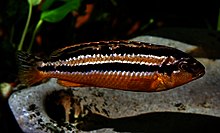

The mbuna cichlids, adapted to life in the rock and scree zone, are food specialists that eat the vegetal and animal growth that covers all the stones and rocks in the upper water layer. They are unable to survive on sandy soil and without boulders and rocks as the basis of their food and therefore avoid even smaller sandy areas. As a result, a large number of isolated individual populations have emerged that have no contact with one another and have developed into color morphs or independent species. The areas that colonize a morph or a species can be very small and in extreme cases only cover the area of a soccer field.
Utaka
"Tilapias"
Catfish

Nile pike

Carp fish
Others
use
The Utaka species that live in large swarms in open water, which are therefore easy to catch in large numbers with nets, and the growing Oreochromis species, Coptodon rendalli and Tilapia sparrmanii, are an important food and protein source for the lake population. The colorful mbuna species in particular are popular aquarium fish and are also known as "freshwater coral fish".
Invertebrates
The invertebrates known in the lake are listed below. Species that only occur in the mouths of the tributaries are not listed.
Molluscs
Snails
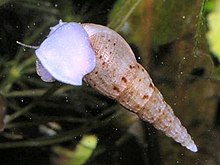
- Plate snails (Planorbidae): Biomphalaria pfeifferi , Bulinus globosus , Bulinus nyassanus end., Bulinus succinoides end., Lanistes ellipticus , Lanistes nasutus , Lanistes nyassanus and Lanistes solidus .
- Marsh snails (Viviparidae): Bellamya capillata end., Bellamya ecclesi end., Bellamya jeffreysi end. and Bellamya robertsoni .
- Bithyniidae (Bithyniidae): Gabbiella stanleyi end.
- Crown snails (Thiaridae): Melanoides tuberculata , Melanoides virgulata , Melanoides nodicincta end, Melanoides simonsi end. and Melanoides polymorpha end.
Shellfish
- from the family Iridinidae : Aspatharia subreniformis , Chambardia nyassaensis and Mutela alata alata .
- River and pond mussels (Unionidae): Coelatura hypsiprymna , Coelatura mossambicensis , Nyassunio nyassaensis and Coelatura nyassaensis .
- Cupcake clams (Corbiculidae): Corbicula africana .
arthropod
Crustaceans
- Branchiopoda (Branchiopoda): Diaphanosoma excisum , Bosmina longirostris , Bosminopsis deitersi , Ceriodaphnia sp. Daphnia lumholtzi , Ilyocryptus sp.
- Fish lice (Branchiura): Argulus africanus , Argulus jollymani , Chonopeltis inermis and Dolops ranarum
- Copepods (Copepoda): 6 species from the order Calanoida , including Thermodiaptomus mixtus and Tropodiaptomus cunningtoni , from the order of Cyclopoida : Eucyclops dubius , Macrocyclops cf. albidus , aequatorialis Mesocyclops , Microcyclops nyasae , two more Microcyclops species, Thermocyclops neglectus , Afrolernaea longicollis , Lamproglena clariae , Lamproglena nyasae , Lernaea Bagri , Lernaea barnimiana , Lernaea hardingi , Lernaea lophiara , Lernaea palati , Lernaea tilapiae and Lernaea sp, 6 species of the order. Harpacticoida including: Schizopera consimilis , as well as, of the order poecilostomatoida , Ergasilus macrodactylus and Trigasilus minutus .
- Shellfish (Ostracoda) a total of 57 species, some of which are endemic.
- Freshwater shrimp (Atyidae): Caridina malawensis
- Crabs (Brachyura) a total of 4 species including Potamonautes lirrangensis
Arachnids
- Arachnids (Arachnida): 5 indeterminate species.
insects
- Under the insect fauna of Lake Malawi, there are dragonflies (Odonata), mayflies (Ephemeroptera), stoneflies (Plecoptera), Hemiptera ( corixidae (Corixidae), Sandpiper (Gerridae) naucoridae (Naucoridae) nepidae (Nepidae), backstroke (Notonectidae)) Beetles (Coleoptera) (families Elmidae and Psephenidae ), two-winged birds (Diptera) and caddis flies (Trichoptera).
Others
- the endemic sponge Malawispongia echinoides .
- the tardigrade Isohypsibius malawiensis .
- three undefined types of roundworms (Nematoda).
- Tapeworms (Cestoda): an undetermined member of the family Dilepididae (host is Copadichromis eucinostomus ), Cichlidogyrus halli (host is Oreochromis s. Shiranus ) and Cichlidogyrus sp. (Hosts are Petrotilapia species).
- Flukes (Trematoda): Haplorchoides cahirinus (hosts are Clarias gariepinus and Bagrus meridionalis ) Clinostomoides brieni (hosts are Clarias TYPES), an indefinite representatives of the family Sanguinicolidae (host is Bathyclarias nyasensis ), Schistosoma haematobium (hosts are the snails Bulinus globose and B. nyassanus ), Schistosoma mansoni (host is the screw Biomphalaria pfeifferi ) Malawitrema staufferi (hosts are Clarias gariepinus and Bagrus meridionalis ) Astiotrema turneri (known hosts are Protomelas annectens , P. cf. taeniolatus , Ctenopharynx pictus , Labeotropheus fuelleborni , L . trewavasae , Maylandia zebra , M. emmiltos and Melanochromis vermivorus ) and Glossidium patum (hosts are Clarias gariepinus and Bagrus meridionalis ).
- Vortex worms (Turbellaria): Mesostoma sp.
- Annelids (Annelida): Epirodrilus mammosus and two Egelarten (Hirudinea sp.).
- three types of rotifers ( Brachionus sp., Keratella sp. and Synchaeta sp.).
- The scratchworms Acanthogyrus (Acanthosentis) malawiensis and Acanthogyrus (Acanthosentis) tilapiae .
Terrestrial vertebrates
The marshland and reed areas by the lake are inhabited by various row frogs (Rhacophoridae) and reed frogs (Hyperoliidae), including the marbled reed frog ( Hyperolius marmoratus ), the water lily frog ( H. pusillus ), Hyperolius nasutus and Hyperolius tuberilinguis . The waterfowl that feed on the numerous fish include the white-breasted cormorant ( Phalacrocorax lucidus ), the more common red reed ( Microcarbo africanus ), the darter ( Anhinga rufa ), pink ( Pelecanus onocrotalus ) and red chalk pelican ( P. rufescens ), Gray heron ( Ardea cinerea ) and Goliath heron ( A. goliath ), the fish eagle ( Haliaeetus vocifer ) as well as the kingfishers' hooded dwarf fishers ( Corythornis cristatus ), stripes ( Halcyon chelicuti ), pygmy king fishers ( Ispidina picta ) and giant fishers ( Megaceryle maxima ). Non-fish-eating birds that can regularly be seen near the shore are the cattle egret ( Bubulcus ibis ) and the greater flamingo ( Phoenicopterus roseus ).
literature
- Horst Linke, Wolfgang Staeck: African cichlids, cichlids from East Africa. Tetra Verlag, 1981, ISBN 3-8974-5103-4
- Hans J. Mayland: The Malawi lake and its fish. Landbuch-Verlag GmbH, Hanover 1982, ISBN 3-7842-0257-8
Individual evidence
- ^ Staeck and Linke (1981): page 13.
- ^ Staeck and Linke (1981): page 57.
- ^ Staeck and Linke (1981): page 17.
- ^ Staeck and Linke (1981): page 10.
- ↑ a b Staeck and Linke (1981): page 12.
- ^ Staeck and Linke (1981): page 141.
- ^ Staeck and Linke (1981): pages 36 and 125.
- ^ Checklist of the Invertebrate Animals of Lake Malawi
- ↑ Richard, J .; and Clark, PF (2009). African Caridina (Crustacea: Decapoda: Caridea: Atyidae): redescriptions of C. africana Kingsley, 1882, C. togoensis Hilgendorf, 1893, C. natalensis Bouvier, 1925 and C. roubaudi Bouvier, 1925 with descriptions of 14 new species. Zootaxa 1995: 1-75
- ↑ Mayland (1982), pp. 81-82.
- ↑ Mayland (1982), pp. 76-81.



